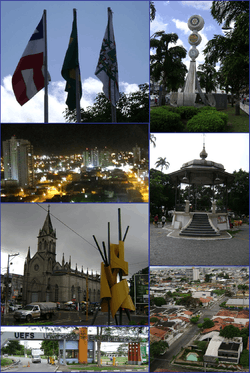Feira de Santana
| Feira de Santana | |||
|---|---|---|---|
| Municipality | |||
| The Municipality of Feira de Santana | |||
|
In clockwise, starting top left: Flags of Bahia, Brazil and Feira de Santana, respectively, in front of City Hall, the Clock Square, Bandstand in the neighborhood Sobradinho; Vista Neighborhood Center Point during the day; Entry UEFS in Transnordestina Avenue , Lord of the Church Steps, View of buildings in the neighborhood Kalilândia overnight. | |||
| |||
 Localization of the city | |||
| Country | Brazil | ||
| Region | Northeast | ||
| State | Bahia | ||
| Government | |||
| • Mayor | José Ronaldo de Carvalho (DEM) | ||
| Area | |||
| • Total | 1,362.880 km2 (526.211 sq mi) | ||
| Elevation | 286 m (938 ft) | ||
| Population (2006) | |||
| • Total | 700,000 | ||
| • Density | 392.8/km2 (1,017/sq mi) | ||
| Time zone | UTC-3 (UTC-3) | ||
| Postal Code | 44000-000 | ||
| Area code(s) | +55 75 | ||
| Website | Feira de Santana, Bahia | ||
Feira de Santana (Portuguese pronunciation: [ˈfejɾɐ dʒi sɐ̃ˈtɐ̃nɐ], Saint Anne's Market) is a city in Bahia, Brazil. It is the second-most populous city in the state, with a population of 740,000 according to IBGE's estimate. It is located 100 km northwest of Salvador, Bahia's capital city. These cities are connected by BR-324, a four-lane divided highway. Feira de Santana's nickname is a princesa do sertão or "the backcountry's princess".
Feira de Santana takes is name in honor of two of its founders. In the 18th century, Domingos Barbosa de Araujo and his wife Anna Brandoa built a chapel on the Fazenda Sant'Anna dos Olhos D’Água (Saint Anna of the Fountains Plantation). They dedicated the chapel to their Saint, Saint Anna. The city is also known as "The Gateway to the Backcountry", for its location in the Agreste zone, a geographic region that separates the wet "Zona da Mata" from the arid and desert "Sertão";
The location gradually became a common stopping point for voyagers and traders from the high sertão of Bahia and from other states on the trail to the port of Cachoeira and other important villages of Bahia. The area also developed a periodic market together with a prosperous cattle commerce.
Eventually many Brazilians and foreigners began to adopt the area that would become Feira de Santanta as their home. The City began to develop with wide streets which were bordered by many commercial houses serving the area's growing population. As the area's growth accelerated, the residents created the City of Feira de Santana. Feira de Santana became the second City in Bahia and the 31st City of Brazil. Feira de Santana's important geographic location and the hospitality of its people continued to attract new residents.
Today, Feira de Santana is the second largest City in Bahia. Feira de Santana also remains an important stopping point for travelers, containing a major junction of Northeastern Brazil's highways. The City functions as a crossroads for the traffic coming from the South and West-Central portions of Brazil and bound for Salvador and other important cities of the northeast. Feira de Santana, thanks in part to its longstanding importance as a crossroads and its proximity to Salvador, is an important and diverse commercial and industrial center. The Universidade Estadual de Feira de Santana is located in the city. The city is the seat of the Roman Catholic Archdiocese of Feira de Santana.
Feira de Santana is famous for its parties and festivals, such as Senhora Sant'Ana in the last week of July (26 July), which features activities such as bumba-meu-boi, segura-a-véia and burrinha. The Micareta carnival party is held 15 days after Passover; the Festival of Violeiros, in September; and the donkey race in November. The city boasts of several interesting tourist destinations including the market of popular arts, the museum of contemporary art and the Antares Astronomical Observatory.
The city is served by Gov. João Durval Carneiro Airport.



